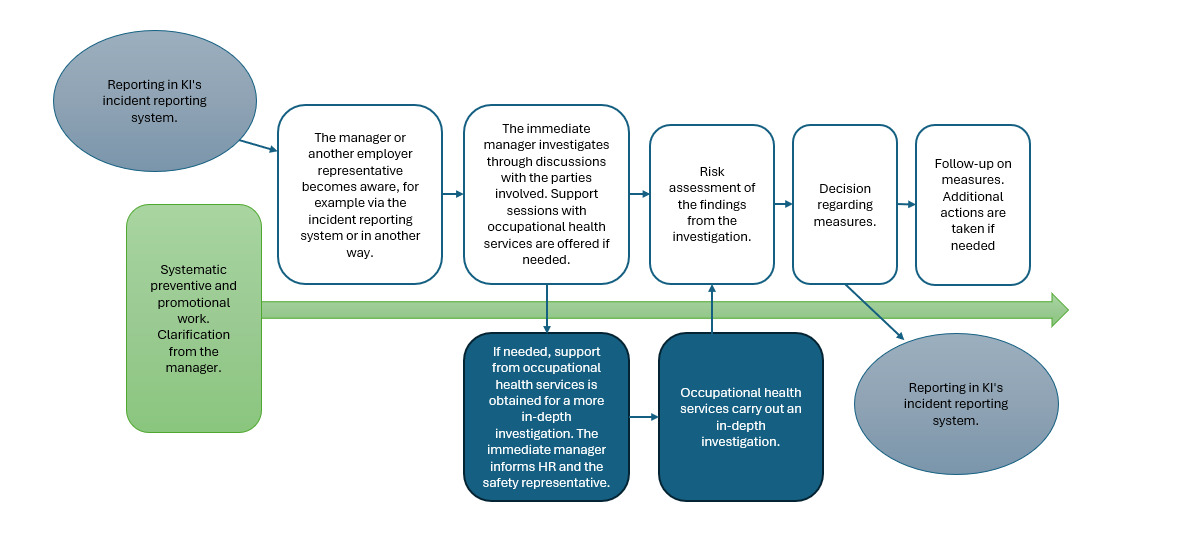Harassment or offensive behavior – what should you do?
On this page, we’ve compiled a guide outlining what to do if you experience harassment or offensive behavior in our workplace.
1. What is harassment and offensive behaviour?
It may involve comments, jokes, looks, or actions that feel unpleasant, demeaning, or threatening. It can relate to gender, ethnicity, religion, disability, sexual orientation, or other personal characteristics. You are the one who determines whether the behavior is unwelcome.
2. Who can you talk to?
Primarily, you should speak with your immediate manager, but you can always talk to someone else you trust. Examples include:
- Employees: Your manager, HR, administrative manager, equal treatment representative, union representative, or safety officer.
- Doctoral students: Director of studies or doctoral student representative.
- Students: Head of department, teacher, study counselor, administrator, student representative, or student safety officer.
- Everyone: You can also report the incident via KI’s incident reporting system.
3. What support is available?
- Employees: Can access counseling support via Falck Health Care (available 24/7) and assistance from trade unions.
- Students: Can receive help from Student Health Services (psychologist, counselor, doctor), student representatives, and disability coordinators.
4. What does the manager do?
The manager must act promptly if someone reports or shows signs of being subjected to harassment. They must:
- Speak with the affected individual.
- Document the conversation and agree on what may be shared.
- Assess whether temporary measures are needed (e.g., separating individuals).
- Speak with the reported individual and inform them of the zero-tolerance policy.
- Offer counseling support to both parties.
- Make an assessment and take appropriate action.
5. What happens in serious cases?
If the situation may involve harassment or offensive treatment, a thorough investigation is conducted by an external and independent party, such as occupational health services. In such cases:
- Those involved are informed about the investigation.
- HR and safety officers are involved.
- The investigator speaks with both parties and possibly others.
- The manager receives a report with suggested actions.
6. What can you do yourself?
- Speak up if you feel safe doing so.
- Ask someone else to speak up on your behalf.
- Write down what happened – it can help you remember details.
- Seek support – you are not alone.
Manager’s responsibility in suspected harassment
As an immediate manager, you are responsible for:
- Investigating the incident promptly and speaking with those involved.
- Contacting HR, occupational health services, and safety officers if needed. If an employee shows signs of or reports offensive treatment or harassment, you must act immediately. The earlier you act, the greater the chance of stopping the behavior and reducing its impact.
Purpose of the investigation
- Clarify what has happened.
- Provide a basis for appropriate actions – both to stop the behavior and prevent recurrence.
- If necessary, serve as grounds for employment-related consequences, such as warnings or salary deductions.
Steps in the investigation
Conversation with the affected individual Take notes, summarize the discussion, and ensure mutual understanding. Decide what may be shared in the investigation. Inform about confidentiality and that documentation may be subject to review.
Temporary measures If needed – e.g., separating individuals during the investigation – to protect the work environment.
Conversation with the reported individual Share what may be disclosed. Clarify that zero tolerance applies to offensive treatment, harassment, and sexual harassment.
Offer counseling support Both parties should be offered support via occupational health services if needed.
Assessment after investigation If the issue involves, for example, collaboration difficulties, a risk assessment is conducted and measures are taken.
In-depth investigation
If you as a manager assess that the case may involve harassment, sexual harassment, or offensive treatment, an in-depth investigation must be conducted by an external and independent party – at MBB, this is handled by occupational health services.
Procedure:
- Inform those involved that an in-depth investigation will be conducted by occupational health services.
- Request a case number from KI’s registrar for documentation.
- Offer counseling again if previously declined.
- Inform HR and safety officers – HR supports the process.
- Contact occupational health services in consultation with HR. They conduct a situation analysis and plan the investigation.
- The investigator contacts those involved and schedules individual interviews.
- The investigator speaks with both parties and possibly other employees.
- The investigator reports back to the manager with conclusions and suggested actions. The manager plans further handling together with HR and, if needed, occupational health services.

